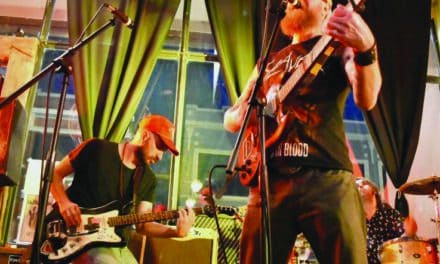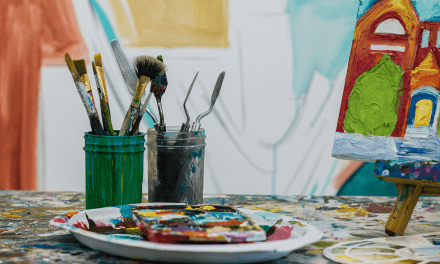By Julie Hines Mabus
“I have lived my life in revolution–not through protest or upheaval but through stillness and calm. There is enough struggle for us. I focus on freedom, rest, quiet, and embracing and projecting beauty–all through my art.”
Those are the words of artist Adrienne Brown-David, an extraordinary woman who works through her oils to empower the lives of black women, one canvas at a time.
I entered Adrienne’s lovely home in Water Valley a few weeks ago. Her dog greeted me and followed us into the living room, where a cat lazed on a cushion, enjoying the morning sun. Adrienne’s easel sat beside the sofa, where we would talk for the next two hours. An unfinished painting of a beautiful young girl with mahogany skin and closely shorn hair stood upright on the easel. I wanted to lift her off the canvas, take her hand, and dance with her in the sunlight like I once did with my own girls.
“She’s stunning.”
“Thank you, that’s my daughter, Zion. It’s for the Harvest Supper this October.” The Harvest Supper is the Friends of the Museum’s annual fundraiser, set on the grounds of Rowan Oak. Curated artists contribute a generous portion of the proceeds when their art is auctioned at the event.
“Much of my work is of my daughters. Since they were little girls, I have photographed them thousands of times. It’s about their growing up years.”
Adrienne has a studio behind her house and uses it for large pieces. “But I mostly work right here. Sometimes I feel isolated in my studio. This way, I do what I love near the people I love. My family is everything to me.”
Adrienne’s is a story of a young girl up in a downtown neighborhood of St. Louis, Missouri. She started kindergarten at a Catholic school in her community. “But I couldn’t stand to wear the uniform. The following year, my mother gave me the option of riding the bus to a school in the suburbs, and I took it. I was a good student. Throughout high school, I was in the gifted program. I’ve always been different, but I’m okay with that.”
From an early age, Adrienne’s artistic talents were supported by her family. Her grandmother, who lived right down the street, saved paper bags for art paper. And her mother volunteered at a gallery in
St. Louis, where Adrienne took art lessons. Further, she was exposed to the triumphs and accomplishments of nationally known exhibiting photographers and painters such as Gordon Parks and Jacob Lawrence.
After high school, Adrienne was admitted to the Art Institute of Chicago. “I spent a year there, but I’m basically self-taught.”
In 2000, when Adrienne was twenty-one, she left Missouri and, on the encouragement of a friend, moved to St. Croix in the U.S. Virgin Islands. Perhaps the choice of St. Croix was serendipitous, but the decision changed the course of Adrienne’s life. She met and married Taariq David from Washington, D.C., who was living on the island and working in the restaurant business.
When Adrienne moved to St. Croix, she was surrounded by the primary colors of one of the most beautiful islands in the Caribbean, great fodder for her art. But life crept in, and she had to get a job. “Tourists were everywhere, and my first job was making them coffee; I was a barista. To tell you the truth, I didn’t care how much mocha or what kind of milk people wanted in their coffee. It just didn’t seem important. I wanted to paint.”
Later, Adrienne worked part-time as a nanny, then in a frame shop, and later as a hotel manager. All the while, she painted, exhibited, and sold her work to the people of St. Croix.
Adrienne eventually met Taariq at one of the local restaurants. “When the global economy started to tank in 2007, we had three girls and another baby on the way. Tourism had practically dried up on the island, and inflation was rampant. We agreed, it was time for us to move.”
“How in the world did you pick Oxford, Mississippi? That seems like a far stretch from the Caribbean.”
“I wanted my girls to be in a community smaller and slower than St. Louis.” The island was all her children had known since they were babies. She had a cousin living in Oxford who encouraged her to come. Eventually, they packed up and headed to Mississippi by way of St. Louis to visit family.
“I started working at the Montessori School when we got to Oxford.”
Taariq approached Andy Douglas, who owned Andy’s Steakhouse right off the Square. Andy immediately gave him a job.
Recently, I found Andy working at Sola on South Lamar. “Oh, yeah, Taariq is great.” I hired him on the spot. The recession hit hard in 2008, and I had to close the restaurant, but he was remarkable.”
The family of six–the fourth girl was born after they left St. Croix–began putting down roots in Oxford. After Adrienne’s work at the school, Taariq’s work with John Currence, and, most recently, at Bar Muse, she could finally spend most of her time with her art.
“People in town began to recognize my paintings. For a few years, I showed at the Ole Miss Motel.”
I was confused. “You mean that old motel on University Avenue, the one that was here when I was in school in the seventies?”
“Yep. They do a show every year, and each artist exhibits in one of the hotel rooms.”
In 2007 Erin Austen Abbot, Oxford native and professional photographer, started the annual exhibition called “One Night Stand at the Ole Miss Motel–what irony. Perfect. The Yocnapatawpha Arts Council now helps in sponsoring the event.
It’s a great concept for emerging artists and their efforts to get before the public. “But, along the way, my work outpriced the event.”
“That is an excellent problem to have. And Water Valley, what precipitated your move?”
“By 2015, we had outgrown our house in Oxford. The girls were older; they needed more room. It was time for a larger space. Water Valley had become an artist community, and the housing prices were more affordable. Taariq dug his heels in at first. He didn’t want to leave Oxford. But a Water Valley friend encouraged us to look at a house, and the neighborhood folks wanted us to move in. We’ve been here eight years. The community has art crawls, Bozarts Gallery, so many things for artists.
Adrienne has home-schooled all her children until they went to high school.” We did bookwork four days a week, following a required curriculum, and then on Fridays, we joined with other families and spent the day in the forest around Water Valley. We called it ‘Forest School.’ There were usually about twenty kids. With each change of season, we would move to a different space. There was very little parental intervention. I kept a nature journal with observations and images. I didn’t paint while we were outside. I just absorbed the beauty of life, of nature.”
“I told you I was self-taught. One good thing the Covid pandemic did for me was to fine-tune my portraiture skills.” Adrienne set up a challenge for herself on Instagram. It started on January 1, 2021. She committed to painting a 5 “x 7” portrait or figure daily for the next year and selling it on social media. “The first two paintings took a few minutes to sell, but by the third day, I had to time stamp the bids to make sure the first bidder got the painting. I never missed a day, and I sold all 365 pieces. Talk about learning how to draw faces…”
“Is it hard to part with these family portraits?”
“I’m not attached to the work itself. I’m attached to the imagery. It’s like reading a book. As you read a book, you have a visual story. It’s the visual story that drives me. I always paint black women.
“We need to see ourselves in spaces we are not in–museums.” Adrienne’s work has hung in the Mississippi Museum of Art. And in her soft-spoken approach to effecting change, she talked of stepping over the line–in calm rather than protest. Art statistics support that position. According to a December 2022 article from “Art Newsletter,” extensive new research across 31 U.S. museums reveals that works by Black American female artists represent only 0.05% of museum acquisitions.
Adrienne’s newest solo exhibition is at Pencil on Paper Gallery in Dallas: “Taken Aback by My Own Beauty: Identity as Rebellion.” The show highlights a twin painting of her daughter Zion. It’s life-size and exudes the power and beauty of a young black woman.
There is no question. Adrienne’s work will hang in museums across the country. But for now, Southside Gallery will host her next show in October. And she will have an exhibition at Fischer Gallery in Jackson next May.
“What’s next for you and Taariq?”
Adrienne and Taariq have been in Mississippi for fifteen years but have traveled extensively as her art has hung in galleries around the country. “I miss the Midwest. Our girls have grown up. Taariq is in Chicago now, scouting it out for a move. It’s time.”
As Mississippi does so well, it changes people. For all its problems and eccentricities, the state and its people get in our blood. And for fifteen years, Adrienne has involved the state’s mysteries and beauty, by design or by accident, into each face, each form, and each matrix of her art. She will carry her revolution wherever she travels; hopefully, Mississippi will travel with her.












